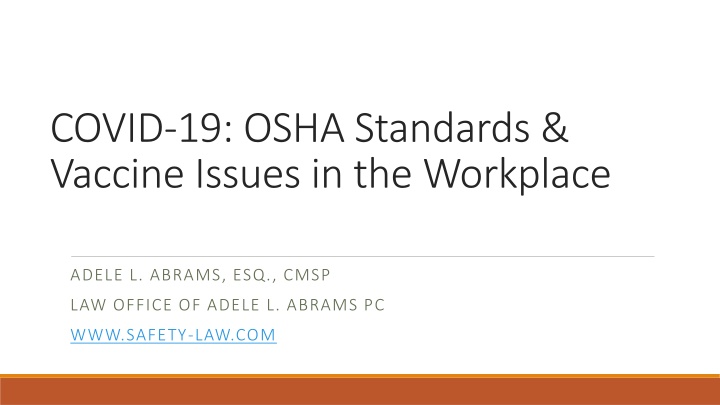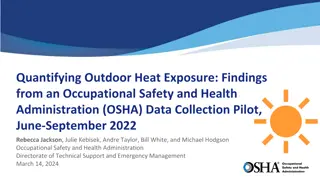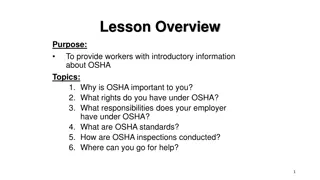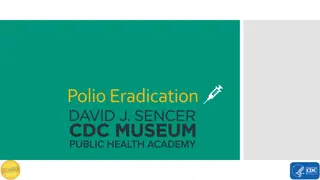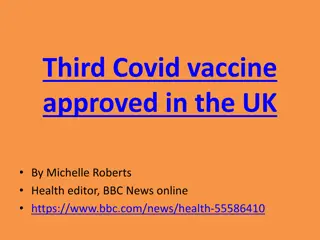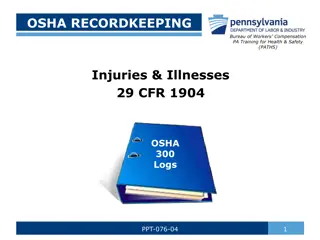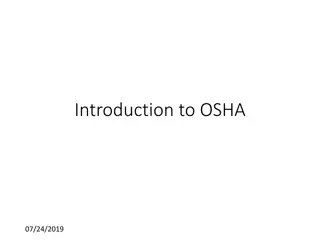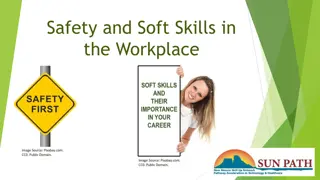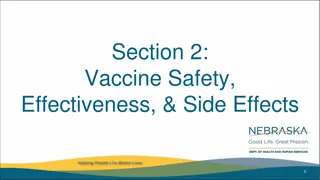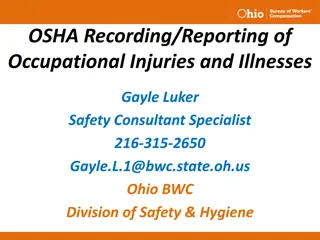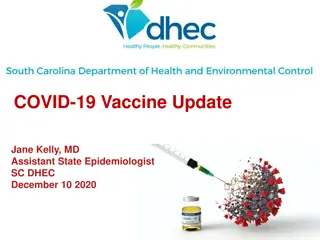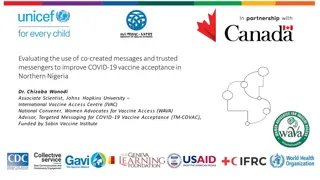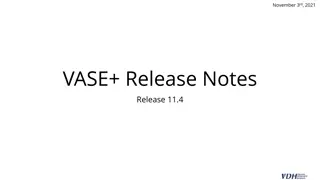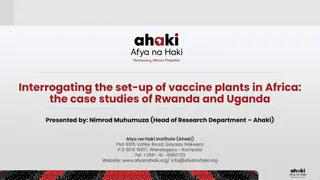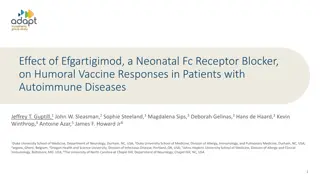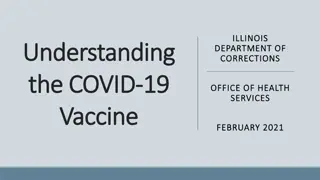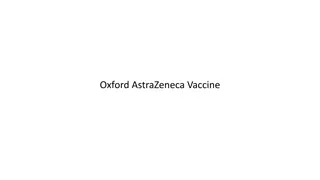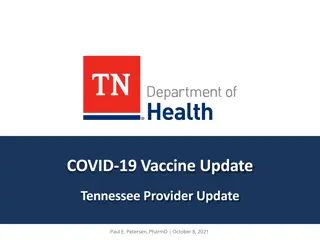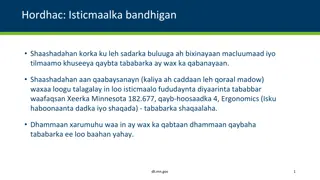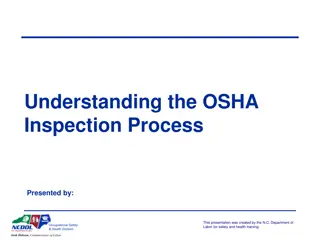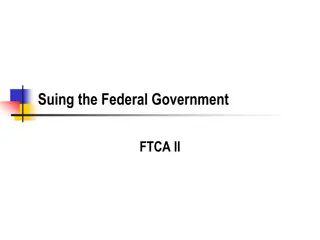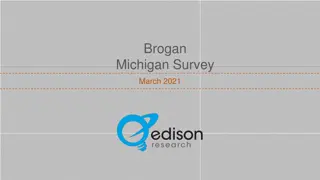OSHA Standards & Vaccine Issues in the Workplace Overview
DOL & State OSHA responses to COVID-19, federal OSHA directives, and ETS for healthcare workers aiming at protecting against COVID-19 hazards. The content highlights key dates, guidance updates, and important information regarding workplace safety measures in response to the pandemic.
Download Presentation

Please find below an Image/Link to download the presentation.
The content on the website is provided AS IS for your information and personal use only. It may not be sold, licensed, or shared on other websites without obtaining consent from the author.If you encounter any issues during the download, it is possible that the publisher has removed the file from their server.
You are allowed to download the files provided on this website for personal or commercial use, subject to the condition that they are used lawfully. All files are the property of their respective owners.
The content on the website is provided AS IS for your information and personal use only. It may not be sold, licensed, or shared on other websites without obtaining consent from the author.
E N D
Presentation Transcript
COVID-19: OSHA Standards & Vaccine Issues in the Workplace ADELE L. ABRAMS, ESQ., CMSP LAW OFFICE OF ADELE L. ABRAMS PC WWW.SAFETY-LAW.COM
Overview: DOL & State OSHA Responses to COVID-19 After issuing shifting/conflicting guidance during 2020, OSHA issued new guidance on 1/29/21, followed by a COVID-19 NEP and an OSHA C-19 enforcement plan on 3/12/21 and an ETS in 6/21 (effective 7/5/21) MSHA issued new guidance 3/21 as well, tracks with OSHA/CDC elements but includes unique recommendations for mining work environments: https://www.msha.gov/protecting-miners CalOSHA, MI-OSHA, OR-OSHA & Virginia OSHA all issued COVID ETS Virginia finalized permanent rule on COVID-19 and has reopened it for amendment/comment! CalOSHA had ATD standard but now adopted ETS and working on additional rules and policy OR-OSHA has permanent COVID-rule to replace ETS but will rescind when state gets to 70% full vax MIOSHA adopted COVID ETS in October 2020 only in effect for 6 mo. WISHA has issued proposed rule intent for infectious disease rulemaking In total, over a dozen states adopted some form of worker safety protections in addition to separate executive orders requiring face masks in the workplace, which have been issued by some governors NJ & NY have workplace safety rules enforced by health dept Amazon now in litigation over exclusive jurisdiction
Federal OSHA Response to C-19 New May 2021 CDC policy on vaccinated persons complicated OSHA guidance and ETS rulemaking CDC says vaccinated persons need not wear masks (indoor or outdoor) but unvaxxed should wear masks indoors but this is for PUBLIC safety (not workplace, which OSHA governs) Biden administration COVID-19 workplace COVID guidance updated June 10, 2021 OSHA issued 67-page directive on ETS enforcement 6/28/21: https://www.osha.gov/sites/default/files/enforcement/directives/DIR_2021-02_CPL_02.pdf OSHA now defines At Risk workers as those with health conditions (transplants, steroid use, immune conditions) who may not have full immune response to vaccination and should continue mask use. Under ADA, these may be required to additional accommodations as must workers who cannot safely wear face coverings Other Biden administration OSHA guidance: 1/29/21: Employer Compliance Guidance: https://www.osha.gov/coronavirus/safework 3/12/21 NEP Link: https://www.osha.gov/enforcement/directives/dir-2021-01cpl-03 3/12/21 Enforcement Memorandum: https://www.osha.gov/memos/2021-03-12/updated-interim- enforcement-response-plan-coronavirus-disease-2019-covid-19
OSHA ETS for Health Care ETS aimed at protecting workers facing the highest COVID-19 hazards in healthcare settings where suspected or confirmed COVID-19 patients are treated ETS takes effective immediately upon publication in the Federal Register. Employers must comply with most provisions by July 5, and with provisions involving physical barriers, ventilation, and training by July 21st. Covers the following workplaces: hospitals, nursing homes, and assisted living facilities; emergency responders; home healthcare workers; and employees in ambulatory care facilities where suspected or confirmed COVID-19 patients are treated. ETS exempts fully vaccinated workers from masking, distancing, and barrier requirements when in well- defined areas where there is no reasonable expectation that any person with suspected or confirmed COVID- 19 will be present.
6/28/21 ETS Enforcement Memo Highlights Clarifies that ETS excludes: 1. the provision of first aid by an employee who is not a licensed healthcare provider; 2. the dispensing of prescriptions by pharmacists in retail settings; 3. non-hospital ambulatory care settings where all non-employees are screened prior to entry and people with suspected or confirmed COVID-19 are not permitted to enter those settings; 4. well-defined hospital ambulatory care settings where all employees are fully vaccinated and all non-employees are screened prior to entry and people with suspected or confirmed COVID-19 are not permitted to enter those settings; 5. home healthcare settings where all employees are fully vaccinated and all non-employees are screened prior to entry and people with suspected or confirmed COVID-19 are not present; 6. healthcare support services not performed in a healthcare setting where direct patient care occurs (e.g., off-site laundry, off-site medical billing); or 7. telehealth services performed outside of a setting where direct patient care occurs. The applicability is also limited where: healthcare setting is embedded within a non-healthcare setting (e.g., medical clinic in a manufacturing facility, walk-in clinic in a retail setting), ETS applies only to the embedded healthcare setting and not to the remainder Where emergency responders or LHCP enter a non-healthcare setting to provide health care services, this section applies only to the provision of the healthcare services by the EMS or LHCP
OSHA ETS Enforcement Directive Directive covers breadth of factors CSHO will consider during site visits, including: Direct inspection of safety gear Interviews with workers Determination as to applicability of standard to workplace (some discretion) Less stringent protections required in well-defined portion of facility where potential C-19 carriers are screened from entry (can be entire department or section of building such as a room or floor) Employers with fully vaccinated workforce who have no reasonable expectation that any C-19 positive person will enter can follow looser requirements, but OSHA may verify employer s assertion by interviewing workers as to their vaccination status and requesting documentation. Any area exemptions must be re-evaluated upon hiring of new, unvaccinated workers CSHOs will grant exemption where some workers are unvaxxed due to health conditions/religion as long as the employer provides reasonable accommodation : Telework, solitary work, or implementation of controls in area exclusively dedicated to unvaxxed employees are accepted by OSHA OSHA says screening methods can be flexible, either in-person or ask workers to self-monitor before reporting to work, and accepted methods include: temperature checks, worker questionnaires and electronic screening apps
OSHA C-19 Guidance 6/10/21 Except for workplace settings covered by OSHA s ETS and mask requirements for public transportation - most employers no longer need to take steps to protect workers from C-19 exposure in any workplace, where ALL EMPLOYEES are fully vaccinated. Employers should take steps to protect unvaccinated or at-risk workers in their workplaces, including: 1. Giving paid time off for employees to get vaccinated 2. Instructing workers who ve had close contact with infected persons, or who are themselves infected, to stay home 3. Implementing physical distancing for unvaxxed or at-risk workers in all communal work areas 4. Protecting unvaxxed or at-risk workers with face coverings or surgical masks, unless work task requires respirator or other PPE 5. Training workers on C-19 policies and procedures in accessible formats and in language they understand 6. Suggesting that unvaxxed customers, visitors and guests wear face coverings 7. Maintaining ventilation systems 8. Performing routine cleaning & disinfection 9. Recording and reporting C-19 infections and deaths* 10.Implementing protections from retaliation and set up anonymous process for workers to voice concerns about C- 19 hazards 11.Following other applicable OSHA mandatory standards (PPE assessment, respiratory protection, sanitation, BBP, medical and exposure records)
OSHA 2021 Enforcement Memorandum: Key Points OSHA will perform onsite inspections, identify C-19 hazard exposures, ensure appropriate controls are implemented, and address violations of OSHA standards and General Duty Clause (Sec 5(a)(1) of OSH Act) OSHA may use phone/video conferencing in lieu of F2F employee interviews to mitigate exposure, and will minimize in-person meetings with employers, and ask for docs to be provided electronically OSHA will continue to prioritize unprogrammed C-19 inspections as well as Programmed NEP Inspections OSHA will consider workplace risk levels using the following factors: Extent of community transmission Type of work activity Ability of workers to wear face coverings and appropriate PPE Extent to which employer follows OSHA standards and CDC guidance Need to work in close contact with other people (within 6 feet for TOTAL of 15 minutes in 24-hour period) May consider mitigation such as vaccines
2021 COVID-19 National Emphasis Program (NEP) NEP includes criteria to identify high hazard industries targeted for enforcement and compliance actions in effect immediately (3/12/21) for one year -- can be amended or canceled Goal of NEP is to significantly reduce or eliminate worker exposures to C-19 by targeting industries and worksites where employees may have a high frequency of close contact exposures and controlling the associated health hazards C-19 NEP includes a focus on Whistleblower Protections & CSHOs will distribute educational information to workers on their rights under Section 11C & 29 CFR Part 1904 NEP uses combination of inspection targeting, outreach to employers, and compliance assistance; if worksite is also under SST, the inspections will be concurrent and wall-to-wall OSHA NEP will include follow up inspections at sites visited in 2020 to monitor efforts 2021 C-19 relief bill included $100 MILLION in additional OSHA funding (above current $592M level) with at least $5M used for C-19 enforcement activities under the NEP and $10M for Harwood Grants Biden administration proposed budget for DOL FY 2022 includes 17% increase overall
MSHA & COVID-19 MSHA guidance requires mine operators to adopt either stand-alone programs or additions to existing training and education programs, that include the following key elements: Conducting a hazard assessment of the mine site ventilation emphasis; Appointing a mine coordinator who will be responsible for C-19 issues on operator s behalf and will regularly communicate with the miners rep or directly with miners; Identifying a combination of measures that limit the spread of COVID-19 in mine settings; Recording and reporting C-19 infections and deaths; Performing enhanced cleaning and disinfecting after people with suspected or confirmed C-19 have been in the mine setting; Providing guidance on screening and testing, and consider making a C-19 vaccine available at no cost to eligible employees; Adopting measures to ensure that miners who are infected or potentially infected are separated and sent home from the mine; Educating and training miners on C-19 policies and procedures in formats and language that they understand; Instructing miners who are infected or potentially infected to stay home and isolate or quarantine and isolating miners who show symptoms at work; Considering protections for miners at higher risk for severe illness through supportive policies and practices; and Implementing protections from retaliation for miners who raise COVID-19-related concerns.
Virginia OSHA (VOSH) Permanent C-19 Standard Virginia issued United States first COVID ETS in 2020 Permanent rule enacted 1/21 with all provisions in effect as of 3/26/21 BUT on 7/1/21 VOSH s standards board releasdd proposed amendments to C=19 standard, with comments due by 7/31/21! Link to info on amendments/comments: https://www.doli.virginia.gov/proposed-changes-to-fps/ and includes marked up 56-page final rule Current final rule modified ETS standard in some ways but retains focus on applying specific provisions to places of employment based on the exposure risk level presented by SARS-CoV-2 virus-related and COVID-19 disease-related hazards present or job tasks undertaken by employees at the place of employment New On-Line positive case reporting link: https://redcap.vdh.virginia.gov/redcap/surveys/?s=LRHNP89XPK Employers may comply with CDC guidelines, both mandatory and non-mandatory, instead as long as CDC recommendation provides equivalent or greater protection than provided by a provision of VOSH rule In order for an employer to take advantage of the provision, it would have to demonstrate that it was complying with language in CDC publications that could be considered both mandatory (e.g., shall , will , etc.) and nonmandatory ( it is recommended that , should , may , etc.). In other words, an employer would have to comply with a CDC recommended practice even if the CDC publication doesn't require it.
VOSH COVID-19 PERMANENT STANDARD VOSH recognizes that various hazards or job tasks at the same place of employment can be designated as very high , high, medium , or lower as presenting potential exposure risk for purposes of application of the requirements of this standard. Factors to consider for types of hazards encountered: Exposure to airborne transmission of COVID-19 Contact with contaminated surfaces or objects (e.g., tools, workstations, break rooms, locker rooms, and entrances and exits to facilities) Shared work vehicles Employer sponsored shared transportation such as ride-share vans, shuttle vehicle, car-pools and public transportation Don t forget to document COVID hazards on your PPE Hazard Assessment under 29 CFR 1910.132
Provisions Applicable to all Virginia Employers Employers shall: assess their workplace for hazards and job tasks with potential COVID-19 exposure classify each job task according to the hazards employees are potentially exposed to and ensure compliance with applicable sections of standard develop and implement policies and procedures for employees to report when they are experiencing signs and/or symptoms consistent with COVID-19, and no alternative diagnosis has been made NOT permit employees known to be infected to report to or be allowed to remain at work or on a job site until cleared for return to work discuss with subcontractors, and companies that provide contract or temporary employees about the importance of suspected COVID-19 and known COVID-19 subcontractor, contract, or temporary employees staying home and encourage them to develop non-punitive sick leave policies notify employees at the place of employment, other employers, and the building/facility owner if an employer is notified of a COVID-19 positive test for one of its own employees, a subcontractor employee, or other person who was present at the place of employment notify VDH and DOLI in certain situations and implement policies and procedures for employee return to work
Workplace Classifications: VOSH Very High Places of employment with high potential for employee exposure to known or suspected sources of COVID-19, or known or suspected to be infected with COVID-19 Group Special medical, postmortem, or laboratory procedures High Places of employment with high potential for employee exposure inside 6 ft with person known or suspected sources of COVID-19, or person known or suspected of being infected with COVID-19 Group Healthcare, first responders, medical transport, mortuary services Medium Not classified as Very High or High, that require more than minimal contact inside 6 ft with other employees, persons, or general public or may be but are not known or suspected to be infected with COVID-19 Group is large and will capture most non-office plant, manufacturing, and construction jobsites. Lower Not classified as Very High, High, or Medium and that does not require contact inside 6 ft with persons known or suspected of being infected with COVID-19 (offices or workplaces that have achieved minimal contact through implementation of engineering, administrative and work practice controls) 14
Other VOSH Rule Provisions Final Rule provides: No enforcement action shall be brought against an employer for failure to provide PPE required by standard, if PPE is not readily available on commercially reasonable terms, and the employer or institution makes a good faith effort to acquire or provide PPE Final Rule could serve as template for federal OSHA ETS - also subject to litigation by business community Final Rule: https://www.doli.virginia.gov/wp-content/uploads/2021/01/Final-Standard- for-Infectious-Disease-Prevention-of-the-Virus-That-Causes-COVID-19-16-VAC25-220- 1.27.2021.pdf Guidance on Final Rule: https://www.doli.virginia.gov/proposed-permanent-standard-for- infectious-disease-prevention-for-covid-19/
Maryland COVID-19 Law MD legislature enacted legislation requiring creation of C-19 workplace safety rules (HR 581) It became law in June 2021, without the governor s signature Requires MOSH to implement an ETS in response to pandemic similar to VOSH rule and to adopt any new federal standard that OSHA issues Allows essential workers to refuse to perform certain tasks as provided under certain circumstances, and requires essential employers to take steps to minimize infectious disease transmission Prohibits employers from discharging or discriminating against an essential worker who files a complaint or exercises other rights under the law Mandates that employers cover COVID-19 testing and report certain test results to MD Dept of health, which must categorize and publish the results Requires employers to grant emergency paid bereavement and public health emergency leave to essential employees during public health emergency on top of existing paid leave
Michigan COVID-19 ETS MIOSHA adopted Emergency Rules for all businesses , with specific requirements for manufacturing, construction, retail, health care amendments made May 24, 2021 MIOSHA has removed the requirement that employers must create a policy prohibiting in-person work for employees to the extent that their work activities can feasibly be completed remotely. The agency has also rescinded the draft permanent COVID-19 rules, and its ETS has been modified effective 5/24/21: Employers may allow fully vaccinated employees to not wear face coverings and social distance provided they have a policy deemed effective to ensure non-vaccinated individuals continue to follow these requirements. The rules have been reformed focusing on performance, eliminating industry-specific requirements. Definitions have been updated to more clearly reflect changes in close contact and quarantining requirements for fully vaccinated employees. Cleaning requirements have been updated to reflect changes in CDC recommendations. Employers should continue to have and implement a written COVID-19 preparedness and response plan in accordance with the updated rules. 17
Cal/OSHA ATD & COVID-19 Cal/OSHA s regulations require protection for workers exposed to airborne infectious diseases such as COVID-19 - California Code, Title 8, Subtitle 5199 CalOSHA COVID-19 resource page: https://www.dir.ca.gov/dosh/coronavirus/ Aerosol Transmissible Diseases (ATD) standard contains requirements for protecting employees from diseases and pathogens transmitted by aerosols Cal/OSHA s ATD Standard applies to: Hospitals, skilled nursing facilities, clinics, medical offices, outpatient medical facilities, home health care, long-term health care facilities, hospices, medical outreach services, medical transport and emergency medical services, correctional facilities, laboratories etc. BUT can be applied at any other locations when Cal/OSHA informs employers in writing that they must comply with the ATD Standard. Cal-OSHA ETS was put in place in all workplaces, but then
Now What, Cal-OSHA? June 9, 2021: CAL-OSHA s Occupational Safety and Health Standards Board held a special meeting to hear from the California Department of Public Health on new face covering guidance, and Board withdrew revisions to the Emergency Temporary Standards that were previously sent to the Office of Administrative Law in order to update Cal/OSHA's COVID-19 prevention requirements with the latest guidance. The board postednew revisions on June 11 that incorporate the latest public health guidance. The revisions were considered at the board s regular meeting on June 17, and rejected 5-1 and Gov. Newsom issued EO making changes immediately effective. NEW RULES: Workplaces must provide masks to workers who are not fully vaxxed and make sure they wear face coverings indoors or in shared work vehicles or employer-provided transport. Employers musts also provide a respirator (N95) if employee who is not yet fully vaccinated requests one. Unvaxxed workers can take off masks indoors only if alone or eating/drinking Cal-OSHA eliminated requirement for solid, cleanable partitions Employers must document vax status of employees who will go without face coverings indoors, but do not have to retain copies of the cards, and employees can self-attest to their inoculation status Review the latest information on the revisions in Cal/OSHA s FAQs: https://www.dir.ca.gov/dosh/coronavirus/Revisions-FAQ.html
OR-OSHA COVID-19 ETS OR-OSHA s ETS rule was adopted 11/6/2020 took effect on 11/16/2020 (with certain parts phased in but all now in effect) and permanent rule has been adopted (subject to modification) Final Rule: https://osha.oregon.gov/OSHARules/div1/437-001-0744.pdf (effective 5/4/2021 - all workplaces) Final version reflects changes from the draft after stakeholder meetings with employer/worker reps Possible Rescission? Oregon OSHA Partnership Committee and Rulemaking Advisory Committees will meet beginning 7/21 at least bimonthly to determine if any parts of the rule can be repealed June 7: Press release stating once OR reaches 70% vax threshold, state will not require masks or face coverings except in transit and health care settings, and OR-OSHA will repeal its requirement at that time Face Coverings & Distancing: includes the requirements, although it removes most such references from the appendices and creates a base requirement for workplaces where the guidance does not apply. ETS/Final Rule: OR-OSHA scrubbed all ETS appendices to eliminate guidance not specific to worker protection, reducing the number of appendices by six and their overall length by more than 70 percent NOTE: Proposed rule language on informing workers about leave rights and also provisions on vaccines were eliminated from final rule
Washington State OSHA May 13: filed notice of possible rulemaking on Occupational Exposures to Infectious or Contagious Diseases - https://www.lni.wa.gov/rulemaking-activity/AO21- 12/2112CR101.pdf Would provide guidelines for state to follow in case of infectious disease outbreak, subject to public health emergency or under national or state declared emergency There will be opportunity for public comment and testimony https://www.lni.wa.gov/rulemaking-activity/
Nevada Dept. of B&I Guidance Issues 5/14/21 applies to all businesses operating in NV, and NV-OSHA imposes new requirements, including: Encourage employees to get COVID-19 vaccine Follow CDC guidance on face coverings but private entities can have more restrictive policies Unvaccinated employees must be provided by employer with face coverings and wear them when in close contact with public or where food is prepared, packaged or distributed Wear face coverings in common areas (unvaxxed) Maintain regular housekeeping practices, cleaning and disinfecting of surfaces and equipment Conduct daily surveys of changes to labor health conditions Provide access to potable and sanitary water Post signage with latest CDC guidance Complete JHA for each task that is identified where transmission of C-19 is an immediate concern
EEOC Guidance on Mandatory Vaccines Guidance addresses how vaccination interacts with ADA, Title VII, ADEA and GINA UPDATED 5/28/2021: https://www.eeoc.gov/wysk/what-you-should-know-about-covid-19-and-ada-rehabilitation-act- and-other-eeo-laws Federal EEO laws do not prevent an employer from requiring all employees physically entering the workplace to be vaccinated for COVID-19, subject to the reasonable accommodation provisions of Title VII and the ADA and other EEO considerations Requesting proof of vaccine is NOT a medical exam prohibited under ADA but avoid reviewing medical screening questionaires (HIPAA/GINA considerations) EEOC currently says that if worker cannot be vaccinated because of disability/religious belief and there are no feasible reasonable accommodations available, employer may lawfully exclude worker from physical workplace Unvaccinated person is not per se a direct threat to safety individualized assessment needed Employer should avoid termination or other adverse actions before carefully evaluating whether worker may work remotely or has protected rights under OTHER employment laws or regulations at federal, state or local level (including state OSHA COVID ETS) Don t forget about FMLA, which may require intermittent leave and could be triggered by new federal Executive Orders or emergency ETS stay alert!
Solutions SAFETY FIRST! With Delta variant on rise (>50% of US cases) and nearly all deaths occurring among unvaccinated persons, enforce mask rules where people are not vaxxed (even vaxxed people can become ill, but are rarely hospitalized) Remember that positive workers must still quarantine for 10 days (or per C-19 standards requirements) and don t forget reporting requirements to health dept and to OSHA! Where feasible, have third party provider (e.g., pharmacy) administer the vaccine and coordinate verification process Evaluate industry conditions and practices (and culture!) to determine whether to implement mandatory vaccination program Consider what specific protections for workers may be required under unique state/municipal employment, OSHA or COVID-specific statutes and regulations one-size-fits-all may not work! Stay abreast of changing guidance from EEOC, NLRB, OSHA as all have new political leadership Consider that under new EO, workers who reasonably refuse a hazardous job will be entitled to unemployment insurance compensation and may also have rights under Section 11(c) of OSH Act (and Section 105(c) of Mine Act)
Questions??? ADELE L. ABRAMS, ESQ., CMSP LAW OFFICE OF ADELE L. ABRAMS PC 301-595-3520 SAFETYLAWYER@GMAIL.COM
